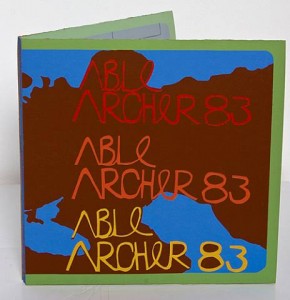
Lisi Raskin, "Able Archer '83," 2008-09. LP recording, artist publication.
Four years ago, when using Google Earth satellites to zoom in on the roofs of our homes was all the rage, I was living in a Hudson River hamlet about an hour north of the city. In my one attempt to join the fun, my search resulted in aerial images depicting my regional topography as a massive black hole—the result of two military complexes and a nuclear power plant just down river. These facilities were not hidden in underground bunkers. Residents were not sworn to secrecy. Yet, national security did not permit me a peek behind the camouflage curtain. Certainly, virtual globes were not readily available in the mid-1970s, but if they had been, Lisi Raskin would have spent her childhood in a hefty Google Earth blank spot; she grew up a few miles from the Miami’s Turkey Point Nuclear Power Plant. Couple this with a memorable viewing of the post-apocalyptic made-for-TV movie, The Day After (1983), that imagined the cold war degenerating in full-scale nuclear holocaust and has fueled her artistic exploration of the military-industrial complex.
Over the past five years, Lisi has toured various facilities constructed throughout the Atomic Age. She spent six months as a resident artist at Bard College’s Center for Curatorial Studies rolling through places like the Davis-Monthan Air Force Base in Tucson, Arizona; Wendover Air Force Base in Utah; and the Nevada Test Sites in Las Vegas. Her engagement with the American frontier centers not on the lore of Manifest Destiny, but rather on a gloomy retelling of militaristic homesteading and recognition of unfortunate people who lived “downwind” of the radiation.
Lisi Raskin, "Wildlife Refuge," 2009 (exterior view), installation at the Athens Bienniale.
In this summer’s Athens Biennale, in the cavernous Esplanade Building built to host the 2004 Summer Olympics, Raskin cleverly depicts a disheartening scene. Her 18-foot-wide Wildlife Refuge (2009), parodies every environmentalist’s worst nightmare: green mountains hollowed out to conceal a bomb production facility. Call me naïve, but when I think of Colorado, it’s Tevas and granola, John Elway, and skiing that come to mind—a place as pure as the snow that dots the Rockies. But for nearly fifty years, the contamination leaking from the Rocky Flats plutonium plant inspired Jackson Browne and Bonnie Raitt to sing to a crowd of demonstrators until Congress agreed to transform the windy plateau back into a wildlife refuge and inspired Raskin to create this work. Clumsily constructed with wobbly painted plywood, the lines of the façade create a diagonal with several peek-holes leading down to the ultimate reveal. Greeted with an eerie dark purple light at the partially-sealed entrance, the viewer feels his anxieties rise at the sight of an empty headquarters and a Kodak slide projector shuffling through retro images of missile statistics, charts, and launch photos. There is a clue to the launch’s target: the Isle of Lesbos, a large Greek Island in the Aegean Sea, which caters primarily to lesbian tourists. Disturbingly, we are not allowed to trespass into the scene and are helpless to alert the islanders of the pending catastrophe.
Lisi Raskin, "Wildlife Refuge," 2009 (interior view), installation at the Athens Bienniale.
In the same year that included her international Biennale debut and stellar reviews for her solo exhibition at the Blanton Museum of Art, University of Texas at Austin, Raskin has suffered two setbacks. First, in mid-February her New York gallery, Guild & Greyshkul (a personal favorite of mine), shut their doors (she is still represented by Country Club Projects in Cincinnati and Milliken Gallery in Stockholm, Sweden). Perhaps an even greater disappointment: after the tremendous high from an invitation to participate in the 11th International Istanbul Biennial came the realization that the U.S. State Department has ceased funding all international biennials (with the exception of Venice).
Raskin’s proposal for Istanbul focuses on travel to Balikesir, where the U.S. Air Force once maintained a cache of B-61 warheads at a strategic point beside the Eastern Bloc. After studying the site, she produced preparatory drawings intended to be used as blueprints for a site-specific installation in the basement of a Greek-language elementary school. Of course there are long-standing animosities between Greece and Turkey. (The 1923 population exchange, or mutual expulsion, nearly brought the neighbors across the Aegean Sea to war.) Lisi’s piece will explicitly render an uneasy climate of students scurrying under desks, ducking and covering, transplanting visitors into a simulacrum of fallout shelters.
Left to our devices we are, essentially, complacent, living in a world that still includes more than 60,000 nuclear weapons in various stages of compilation and forms. For many, the 46 years of military tensions and arms races are part of the distant past, plot lines from Mad Men. If Raskin’s work demonstrates the need for nuclear disarmament by employing fantastically playful replications of control centers—perhaps it’s utopian fantasy, but everything begins with re-engagement—so be it. Hopefully, private donors will step in now that federal funding has failed her. Maybe we can get Jackson Browne and Bonnie Raitt to play a benefit.
You can support Lisi Raskin at: https://www.iconoclastusa.com/EditionsArtists.aspx?Section=Editions&ArtistID=319&EditionID=1201&Page=1.